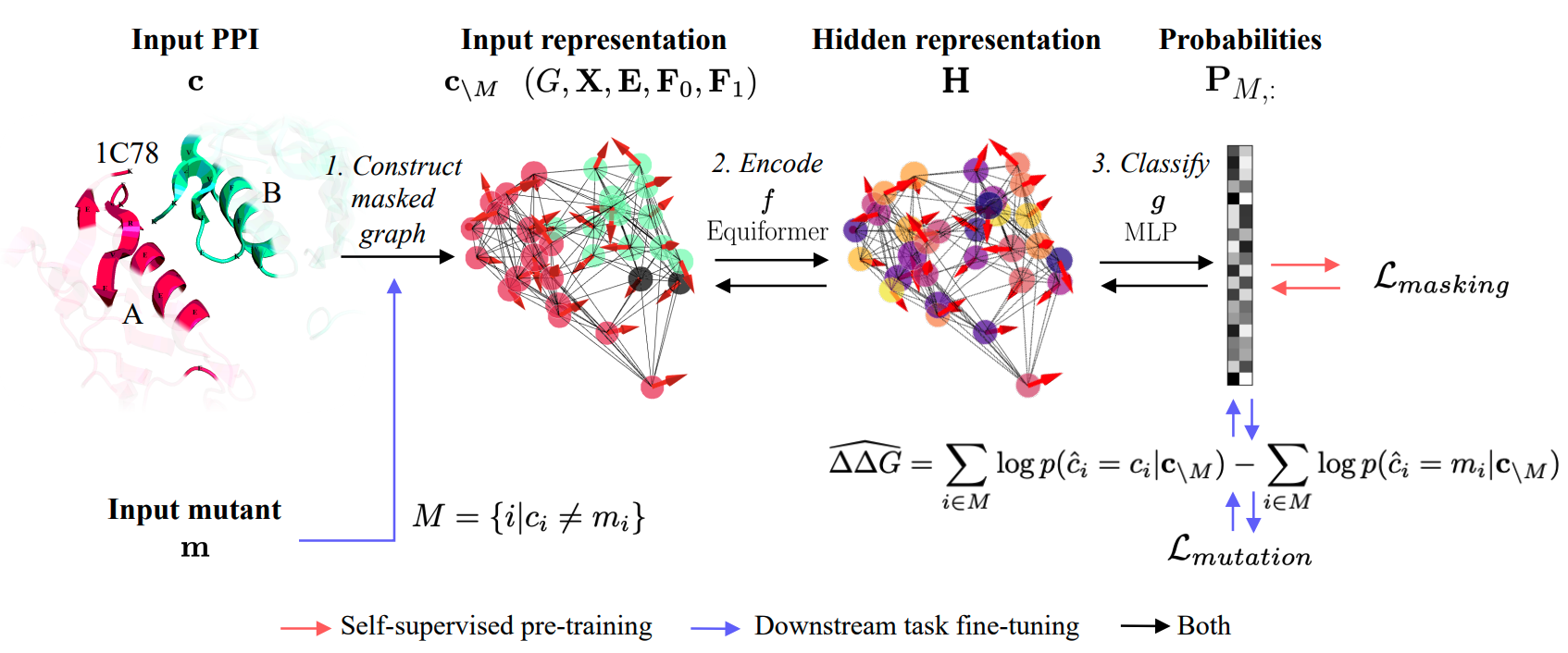PPIformer is a state-of-the-art predictor of the effects of mutations on protein-protein interactions (PPIs), as quantified by the binding energy changes (ddG). The model was pre-trained on the PPIRef dataset via a coarse-grained structural masked modeling and fine-tuned on SKEMPI v2.0 via log odds. PPIformer was shown to successfully identify known favorable mutations of the staphylokinase thrombolytic and a human antibody against the SARS-CoV-2 spike protein. Please see more details in our paper.
Please do not hesitate to contact us or create an issue/PR if you have any questions or suggestions. ✌️
The preview of PPIformer is available via an interactive user interface on Hugging Face Spaces:
Step 1. To install PPIformer locally, clone this repository and install the environment (you may need to adjust the versions of the PyTorch-based packages in the script depending on your system):
conda create -n ppiformer python==3.10 -y
conda activate ppiformer
git clone https://github.com/anton-bushuiev/PPIformer; cd PPIformer
pip install -e .Step 2. After installation, you may need to adapt PyTorch to your system. Please see the official PyTorch installation guide for details. For example, if you are using AMD GPUs, you may need to install PyTorch for ROCm:
pip install -U torch --index-url https://download.pytorch.org/whl/rocm6.0import torch
from ppiformer.tasks.node import DDGPPIformer
from ppiformer.utils.api import download_from_zenodo, predict_ddg
from ppiformer.definitions import PPIFORMER_WEIGHTS_DIR, PPIFORMER_TEST_DATA_DIR
# Download the weights
download_from_zenodo('weights.zip')
# Load the ensamble of fine-tuned models
device = 'cpu'
models = [DDGPPIformer.load_from_checkpoint(PPIFORMER_WEIGHTS_DIR / f'ddg_regression/{i}.ckpt', map_location=torch.device(device)).eval() for i in range(3)]
# Specify input
ppi_path = PPIFORMER_TEST_DATA_DIR / '1bui_A_C.pdb' # PDB or PPIRef file (see https://ppiref.readthedocs.io/en/latest/extracting_ppis.html)
muts = ['SC16A', 'FC47A', 'SC16A,FC47A'] # List of single- or multi-point mutations
# Predict
ddg = predict_ddg(models, ppi_path, muts)
ddg
> tensor([-0.3708, 1.5188, 1.1482])To train and validate PPIformer, please see PPIformer/scripts/README.md. To test the model and reproduce the results from the paper, please see PPIformer/notebooks/test.ipynb.
The model was pre-trained on the PPIRef dataset via a coarse-grained structural masked modeling and fine-tuned on the SKEMPI v2.0 dataset via log odds.
A single pre-training step starts with randomly sampling a protein-protein interaction (in this example figure, the staphylokinase dimer A-B from the PDB entry 1C78) from PPIRef. Next, randomly selected residues
are masked to obtain the masked interaction
. After that, the interaction is converted into a graph representation
with masked nodes
(black circles). The model subsequently learns to classify the types of masked amino acids by acquiring
-invariant hidden representation
of the whole interface via the encoder
and classifier
(red arrows). On the downstream task of ddG prediction, mutated amino acids are masked, and the probabilities of possible substitutions
are jointly inferred with the pre-trained model. Finally, the estimate
is obtained using the predicted probabilities
of the wild-type
and the mutant
amino acids via log odds (blue arrows).
- Pre-training and fine-tuning examples with
scripts/run.py - Installation script examples for AMD GPUs and NVIDIA GPUs
- SSL-pretrained weights (without fine-tuning)
If you find this repository useful, please cite our paper:
@article{
bushuiev2024learning,
title={Learning to design protein-protein interactions with enhanced generalization},
author={Anton Bushuiev and Roman Bushuiev and Petr Kouba and Anatolii Filkin and Marketa Gabrielova and Michal Gabriel and Jiri Sedlar and Tomas Pluskal and Jiri Damborsky and Stanislav Mazurenko and Josef Sivic},
booktitle={The Twelfth International Conference on Learning Representations},
year={2024}
}



